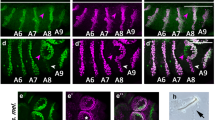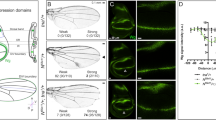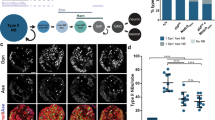Abstract
IT is generally accepted that the specific function of a gene depends on its coding sequence. The three paired-box and homeobox genes paired (prd), gooseberry (gsb) and gooseberry neuro (gsbn) have distinct developmental functions in Drosophila embryogenesis1–5. During the syncytial blastoderm stage, the pair-rule gene prd4,6 activates segment-polarity genes, such as gsb7, wingless (wg)9 and engrailed (en), in segmentally repeated stripes8. After germ-band extension, gsb maintains the expression of wg, which in turn specifies the denticle pattern by repressing a default state of ubiquitous denticle formation in the ventral epidermis9. In addition, gsb activates gsbn5, which is expressed mainly in the central nervous system2,3, suggesting that gsbn is involved in neural development. Here we show that, despite the functional difference and the considerably diverged coding sequence of these genes, their proteins have conserved the same function. The finding that the essential difference between genes may reside in their cis-regulatory regions exemplifies an important evolutionary mechanism of how function diversifies after gene duplication.
This is a preview of subscription content, access via your institution
Access options
Subscribe to this journal
Receive 51 print issues and online access
$199.00 per year
only $3.90 per issue
Buy this article
- Purchase on Springer Link
- Instant access to full article PDF
Prices may be subject to local taxes which are calculated during checkout
Similar content being viewed by others
References
Noll, M. Curr. Opin. Genet. Dev. 3, 595–605 (1993).
Bopp, D., Burri, M., Baumgartner, S., Frigerio, G. & Noll, M. Cell 47, 1033–1040 (1986).
Baumgartner, S., Bopp, D., Burri, M. & Noll, M. Genes Dev. 1, 1247–1267 (1987).
Gutjahr, T., Frei, E. & Noll, M. Development 117, 609–623 (1993).
Gutjahr, T., Patel, N. H., Li, X., Goodman, C. S. & Noll, M. Development 118, 21–31 (1993).
Kilchherr, F., Baumgartner, S., Bopp, D., Frei, E. & Noll, M. Nature 321, 493–499 (1986).
Bopp, D., Jamet, E., Baumgartner, S., Burri, M. & Noll, M. EMBO J. 8, 3447–3457 (1989).
Ingham, P. W. & Martínez-Arias, A. Cell 68, 221–235 (1992).
Li, X. & Noll, M. EMBO J. 12, 4499–4509 (1993).
Struhl, G. Nature 318, 677–680 (1985).
Ish-Horowicz, D. & Pinchin, S. M. Cell 51, 405–415 (1987).
Morrissey, D., Askew, D., Raj, L. & Weir, M. Genes Dev. 5, 1684–1696 (1991).
Manoukian, A. S. & Krause, H. M. Genes Dev. 6, 1740–1751 (1992).
Manoukian, A. S. & Krause, H. M. Development 118, 785–796 (1993).
Frasch, M., Hoey, T., Rushiow, C., Doyle, H. & Levine, M. EMBO J. 6, 749–759 (1987).
Doe, C. Q., Smouse, D. & Goodman, C. S. Nature 333, 376–378 (1988).
Patel, N. H., Schafer, B., Goodman, C. S. & Holmgren, R. Genes Dev. 3, 890–904 (1989).
Li, X., Gutjahr, T. & Noll, M. EMBO J. 12, 1427–1436 (1993).
Frigerio, G., Burri, M., Bopp, D., Baumgartner, S. & Noll, M. Cell 47, 735–746 (1986).
Côté, S. et al. EMBO J. 6, 2793–2801 (1987).
Bejsovec, A. & Martínez-Arias, A. Development 113, 471–485 (1991).
Hoey, T. & Levine, M. Nature 332, 858–861 (1988).
Jacob, F. Science 196, 1161–1166 (1977).
Thomas, K. R. & Capecchi, M. R. Nature 346, 847–850 (1990).
McMahon, A. P. & Bradley, A. Cell 62, 1073–1085 (1990).
Joyner, A. L., Herrup, K., Auerbach, B. A., Davis, C. A. & Rossant, J. Science 251, 1239–1243 (1991).
Lohnes, D. et al. Cell 73, 643–658 (1993).
Wieschaus, E. & Nüsslein-Volhard, C. in Drosophila, a Practical Approach (ed. Roberts, D. B.), 199–227 (IRL Press, Oxford, 1986).
Dambly-Chaudière, C. et al. Cell 69, 159–172 (1992).
Rubin, G. M. & Spradling, A. C. Science 218, 348–353 (1982).
DiNardo, S. & O'Farrell, P. H. Genes Dev. 1, 1212–1225 (1987).
van den Heuvel, M., Nusse, R., Johnston, P. & Lawrence, P. A. Cell 59, 739–749 (1989).
Hidalgo, A. Mech. Dev. 35, 77–87 (1991).
Klemenz, R., Weber, U. & Gehring, W. J. Nucleic Acids Res. 15, 3947–3959 (1987).
Maxam, A. M. & Gilbert, W. Proc. natn. Acad. Sci. U.S.A. 74, 560–564 (1977).
Stanojevic, D., Hoey, T. & Levine, M. Nature 341, 331–335 (1989).
Author information
Authors and Affiliations
Rights and permissions
About this article
Cite this article
Li, X., Noll, M. Evolution of distinct developmental functions of three Drosophila genes by acquisition of different cis-regulatory regions. Nature 367, 83–87 (1994). https://doi.org/10.1038/367083a0
Received:
Accepted:
Issue Date:
DOI: https://doi.org/10.1038/367083a0
This article is cited by
-
Young duplicate genic DNA
Nature Ecology & Evolution (2021)
-
Regulatory gene function handoff allows essential gene loss in mosquitoes
Communications Biology (2020)
-
Sequence and functional analysis of cis-elements associated with MIR159 loci from Brassica juncea reveal functional diversification and complex transcriptional regulation
Plant Growth Regulation (2020)
-
Evolution of cis-regulatory sequence and function in Diptera
Heredity (2006)
-
Reciprocal gene replacements reveal unique functions for Phox2 genes during neural differentiation
The EMBO Journal (2005)
Comments
By submitting a comment you agree to abide by our Terms and Community Guidelines. If you find something abusive or that does not comply with our terms or guidelines please flag it as inappropriate.



